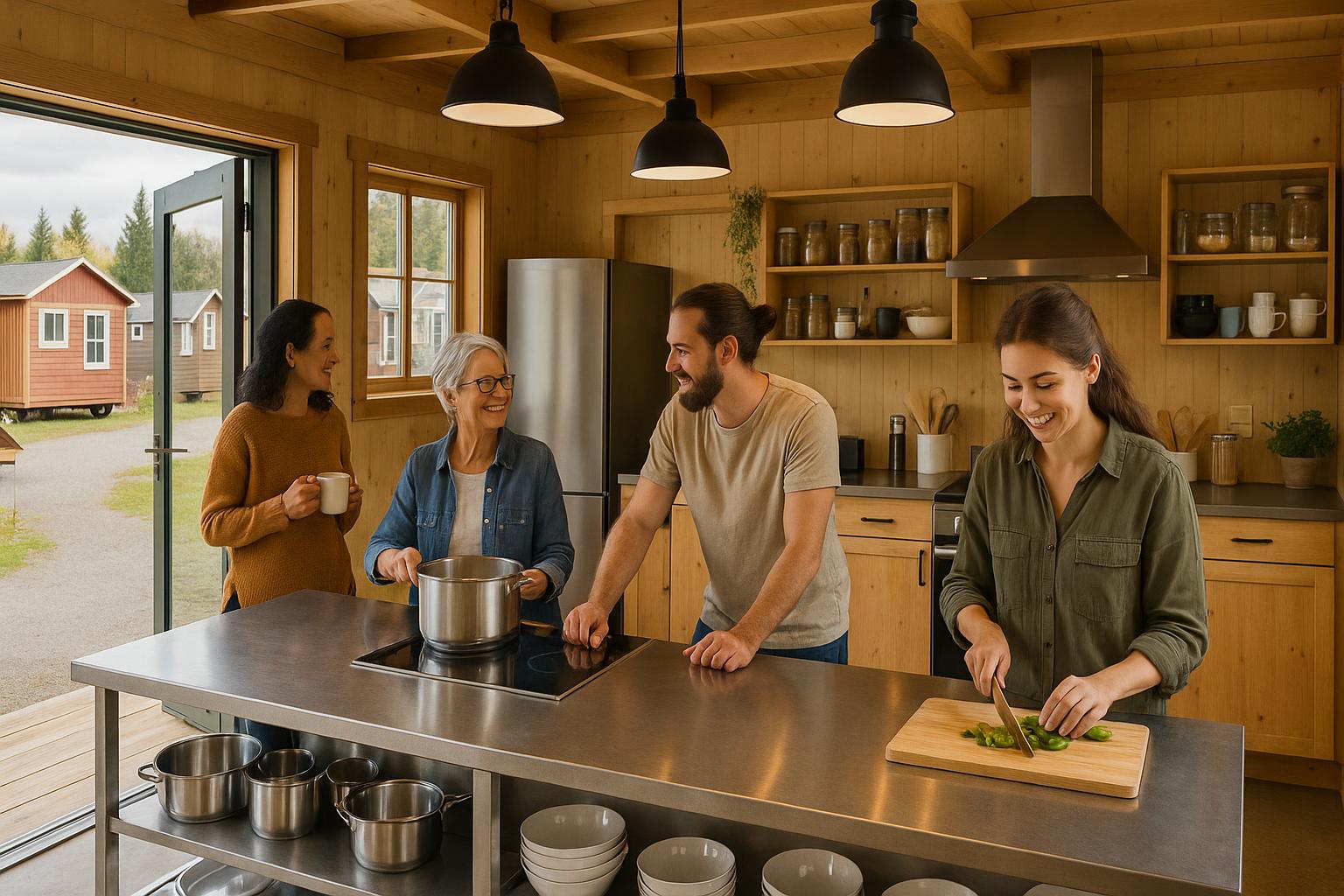
Communal Kitchens: Enhancing Small Space Living in Canadian Tiny Home Communities
Estimated reading time: 8 minutes
Key Takeaways
- Communal Kitchens provide shared cooking and food preparation spaces that are essential to maximizing space efficiency in tiny home communities.
- They foster strong community bonds, promote resource sharing, and are a key amenity in addressing high real estate costs and limited space.
- Effective design using small space principles and adherence to legal standards ensures safety, comfort, and functionality.
- Facing challenges like scheduling and hygiene, communal kitchens benefit from clearly defined community guidelines and smart design solutions.
- The future of communal kitchens is bright with emerging smart technology, flexible design, and shifting housing policies.
Table of contents
- Introduction: Communal Kitchens and the Tiny Home Community in Canadian Housing
- Overview of Tiny Home Communities and Canadian Housing Trends
- What Are Communal Kitchens?
- Design Considerations for Communal Kitchens in Tiny Home Communities
- Legal and Regulatory Aspects in Canadian Housing
- Social Benefits of Communal Kitchens
- Challenges and Solutions
- Future Outlook and Trends
- Conclusion
- Frequently Asked Questions
Introduction: Communal Kitchens and the Tiny Home Community in Canadian Housing
Communal kitchens are shared cooking and food preparation spaces designed for multiple households, most often within tiny home communities. Unlike private kitchens, these spaces serve both practical and social functions.
Across Canada, tiny home communities are increasingly popular. High real estate prices, limited urban space, and the pursuit of sustainable lifestyles are driving demand for shared amenities like communal kitchens.
This blog explores how communal kitchens optimize small space living by addressing legal standards, design principles, and social benefits. Research informing this discussion includes “Tiny Homes: Alternative to Conventional Housing” by BC Housing and Ontario’s “Build or Buy a Tiny Home” guide.
For more on small space living and tiny home lifestyles, check out our comprehensive guide on Tiny Home Living: Your Complete Guide to Micro Homes, Sustainability, and Lifestyle Freedom.
Overview of Tiny Home Communities and Canadian Housing Trends
Growth in Tiny Home Community Living
Tiny home communities are on the rise throughout Canada due to:
- Rising real estate costs that make traditional homeownership challenging.
- Urban densification policies which promote efficient land use.
- Demand for flexibility and sustainability through alternative housing forms.
These communities typically consist of several small dwellings (often under 500 square feet) clustered on shared property, featuring amenities like gardens, laundries, and communal kitchens.
For additional insights on the benefits of tiny home communities, visit How Tiny Home Communities Are Redefining Affordable, Eco-Friendly, and Communal Living.
Shared Spaces as a Key Feature
Shared amenities enhance efficiency and foster social connections by:
- Reducing individual living costs
- Encouraging resource sharing
- Maximizing land use through collective facilities
Data from BC Housing (source) and Ontario’s guide (source) underscores the importance of communal spaces in making tiny home communities viable.
Learn more about efficient small space design at Small Homes: Compact Living and Efficient Home Design for Stylish and Functional Urban Spaces.
What Are Communal Kitchens? A Central Shared Space in Tiny Home Communities
Communal kitchens are shared cooking and dining facilities designed for all community residents. They act as hubs for meal preparation, social gatherings, and fostering neighbourly connections.
In tiny home communities, these kitchens help:
- Optimize space in individual homes
- Provide access to larger, more efficient appliances and equipment
- Create opportunities for shared meals and social integration
Communal Kitchens versus Private Kitchens
| Feature | Communal Kitchen | Private Kitchen (Tiny Home) |
|---|---|---|
| Space Efficiency | Centralized, reducing unit size | Consumes significant room in each home |
| Community Interaction | High – encourages group activities | Low – isolation with less engagement |
| Resource Sharing | Shared cookware, appliances, and food storage | Duplication leads to inefficiency |
The BC Housing report (source) and Ontario’s planning documents (source) emphasize that in small spaces, communal kitchens not only maximize available space but also cultivate community belonging.
For further insights, read How Tiny Home Communities Are Redefining Affordable, Eco-Friendly, and Communal Living.
Design Considerations for Communal Kitchens in Tiny Home Communities: Small Space Design in Action
Applying small space design principles is crucial for successful communal kitchens.
Key Principles of Small Space Design
- Multifunctionality: Every element should serve multiple purposes, e.g., a central island providing prep space, dining area, and storage.
- Flexibility: Reconfigurable spaces with folding tables, stackable chairs, and sliding panels adapt to various events.
- Ergonomic Layout: Ensures smooth movement even during busy use.
Layout Suggestions
- Central Prep/Dining Islands for multi-user convenience
- Modular Cabinetry with adjustable shelves and movable drawers
- Folding Tables and Open Shelves for maximizing vertical space
Essential Space-Saving Features
- Compact appliances sized for group use
- Overhead and stacked storage for utensils and cookware
- Under-counter refrigeration and shared pantries
Both the BC Housing study (source) and Ontario’s guidance (source) stress designing for efficient circulation and clear functional zones.
Discover more about small space design in tiny homes at Tiny Home Living: The Ultimate Guide to Affordable, Sustainable, and Stylish Compact Living.
Legal and Regulatory Aspects in Canadian Housing: Rules for Communal Kitchens
Legal Considerations for Communal Kitchens
Canadian housing regulations for communal kitchens vary by province and municipality, making it essential to understand local guidelines to ensure safety and compliance.
Zoning Laws and Building Codes
- Local zoning laws determine where shared amenities can be established.
- Both the Ontario and BC Building Codes set standards for kitchen areas, fire safety, sanitary conditions, and accessibility.
- Municipal bylaws may require special permits or impose restrictions on communal facilities.
Tiny home communities with communal kitchens are relatively new in Canada, which sometimes complicates the approval process. For more detailed perspectives, visit Tiny Home Permits in British Columbia: A Complete Guide or Tiny Home Permits in Ontario: Your Complete Guide.
Also consult Build or Buy a Tiny Home (Ontario Guide) for additional regulatory insights.
Challenges and Solutions: Making Communal Kitchens Work in Tiny Home Communities
Common Challenges
- Hygiene: Increased traffic necessitates frequent cleaning.
- Scheduling: Shared use can lead to conflicts over kitchen time.
- Privacy: Finding a balance between communal activity and personal space can be difficult.
Practical Solutions
- Clear Guidelines: Establish written routines and schedules for cleaning and equipment use.
- Scheduling Systems: Utilize sign-up boards or digital calendars to equitably manage kitchen usage.
- Thoughtful Design: Incorporate visual screens and movable partitions to offer privacy without sacrificing a communal feel.
Both Ontario’s and BC Housing’s guidelines recommend structured community agreements to maintain a clean and efficient shared kitchen environment. For more on community management, check How to Create Effective Tiny Home Community Workshops: A Step-by-Step Guide for Canadian Neighborhoods.
Future Outlook and Trends: Where Communal Kitchens in Canadian Tiny Home Communities Are Headed
Design and Technology Trends
- Smart Technology: Advanced appliance management and digital scheduling tools are emerging.
- Flexible Spaces: Modular counters and multipurpose furniture allow easy reconfiguration.
- Sustainable Materials: Eco-friendly finishes and energy-efficient appliances are gaining traction.
Policy and Cultural Shifts
- Local housing policies are increasingly accommodating shared living solutions amidst housing shortages.
- Emphasis on multicultural living supports community-driven design and collective cooking traditions.
For further reading on policy changes and future trends, see Canada Tiny House Builders Guide and Multicultural ADU: Inspiring Tiny Home Design Ideas for Canada’s Diverse Multi-Generational Living.
Conclusion: Communal Kitchens Are Vital for Canadian Tiny Home Communities
Communal kitchens are more than just shared cooking spaces – they are integral to the sustainability and social cohesion of Canadian tiny home communities. By optimizing limited space, promoting community interaction, and pooling resources, these kitchens offer a pragmatic solution to modern housing challenges.
As regulations evolve and best practices are refined, communal kitchens are set to become a cornerstone of innovative housing solutions. For additional resources, consider visiting:
- BC Housing: Tiny Homes: Alternative to Conventional Housing (PDF)
- Ontario Government: Build or Buy a Tiny Home
- The Tiny Life Guide: Canada Tiny House Builders Guide
And, for further insights into small space living:
- Tiny Home Living: Your Complete Guide to Micro Homes, Sustainability, and Lifestyle Freedom
- How Tiny Home Communities Are Redefining Affordable, Eco-Friendly, and Communal Living
- Small Homes: Compact Living and Efficient Home Design for Stylish and Functional Urban Spaces
Embracing communal kitchens unlocks the full potential of small space design and paves the way for sustainable, community-focused living in Canada.
Frequently Asked Questions
Q1: What is the main purpose of a communal kitchen in tiny home communities?
A: Communal kitchens are designed to maximize space, reduce individual housing costs, and promote social interaction by providing a centralized cooking and dining hub.
Q2: How do communal kitchens help address legal and safety concerns?
A: They are designed in compliance with local zoning, building codes, and health regulations, ensuring adequate space, fire safety, hygiene, and accessibility standards are met.
Q3: What are some common design features of communal kitchens?
A: Key features include multifunctional islands, modular cabinetry, compact and energy-efficient appliances, and flexible layouts that allow for easy reconfiguration based on community needs.
Q4: What challenges can arise with communal kitchens, and how can they be managed?
A: Challenges include hygiene management, scheduling conflicts, and privacy issues. These can be managed with clear community guidelines, digital booking systems, and thoughtfully designed spaces that balance communal and private needs.
Q5: What does the future hold for communal kitchens in tiny home communities?
A: With advances in smart technology, sustainable materials, and evolving housing policies, communal kitchens are expected to become more efficient, user-friendly, and integral to modern, eco-friendly living solutions in Canada.

Leave a Reply